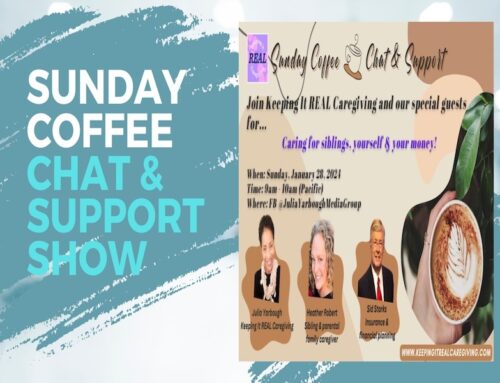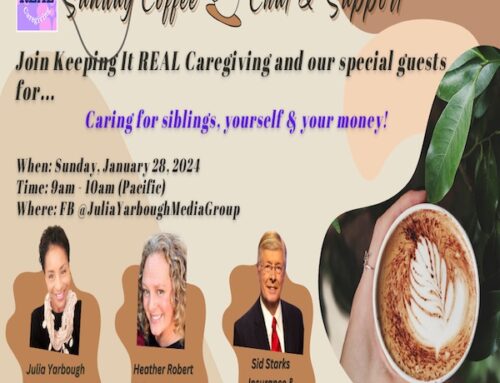Let the learning begin!

Welcome to the Keeping it REAL Caregiving newsletter and glad you are here!
I call it REAL caregiving because as we roll forward, we are going to talk about some of the nitty-gritty aspects of being a caregiver. I know. I have lived the role.
Be sure to SUBSCRIBE NOW so you don’t miss any information, stories, resources and more…
My name is Julia Yarbough and I spent the past 20 years serving as the primary caregiver for my elderly mother. I’m also a lifelong broadcast journalist and storyteller.
So what better combination and set of skills to be able to help others move through this phase of life (and duties)?
In the KIRC welcome letter, I shared some of the following information but I want to make sure those of you just joining us don’t miss anything.
I’m talking about numbers… the numbers of people here in the United States who are already family caregivers and what the projections are for the future.
It can be a bit overwhelming but I want this information to sink in. I want it to stick… to help you truly understand what lies ahead.
Caregiving landscape

Courtesy: AARP & NAC
The AARP Caregiving in the US 2020 Research Report indicates there are currently 43.5 million caregivers in the United States. As our population continues to age that number is expected to climb even higher.
Consider this: caregivers come in all ages, from the young to the middle-aged to the elderly themselves.
And how many of you believe it is only women who are family caregivers?

Courtesy: AARP
If you think that is the case – think again. A growing number of men also serve in this role. And more often than not, direct relatives are providing the care for a loved one.

Courtesy: AARP: Caregiving in the US 2020
I recently asked all of you the question ‘who believes they are a caregiver?’ There is a specific reason I put that question out there.
You see, if someone had asked me that question in January 2000, I would have answered, “No! I am NOT a family caregiver!”
And chances are I would have been indignant and almost angry at the suggestion. In retrospect, I see now it would have been beneficial for me, my mother and other family members to have recognized at that moment, I was a family caregiver.

Nellie & Julia Yarbough/South Florida
When did it happen?
The reality was the moment I helped my mother move from Northern California to live near me in South Florida was the moment I became a caregiver.
Mom lived in her own home and seemed 100% self sufficient. It turns out she wasn’t. My efforts to help my mother included:
Packing and selling her home in the Northern California community where I grew up; Fairfield
Moving her to Florida
Locating and purchasing her new home
Securing health insurance, doctors and specialists
Providing transportation
Finding a Senior Day Care and Activities center
In addition to those tasks there was another reality: if someone saw me they likely also saw Miss Nellie. She joined me for outdoor excursions, speaking events, luncheons, galas and all manner of work-related public appearances.
So Let me ask you this: are you currently doing ANY or ALL of these tasks for a loved one?
If so, then whether you realize it or not you ARE a family caregiver.
Welcome to the club
In 2000, I did not want to be a caregiver. Even the word held negative connotations for me. It meant I was burdened, responsible and locked in place. And quite honestly I did not want that responsibility. Does any of that sound like you?
I knew my mother was aging but surely one of my siblings would swoop in and take over, right?
That didn’t happen. Instead, I grew into my role as a caregiver. But because I refused to accept my new role early, I believe I wasted valuable time educating myself to all of the ‘what-if’ scenarios that come along with aging.

Courtesy: Adobe Stock
Planning and preparing
Part of being an effective caregiver is accepting early and quickly that this is your role.
You can kick and scream and be angry all you want (and yes, I did that too) but none of that will make the reality facing you go away.
Here’s the deal: the sooner you accept and embrace this new role the sooner you can begin to plan and prepare and put necessary items in order. In other words, the sooner you can get down to tackling chores in a practical manner.
You know how emergency managers tell all of us to plan & prepare for emergency situations, like fire and hurricanes? Well, that is how I suggest approaching family caregiving. Hope for the best but plan for the worst.
In fact, I think it’s important to have as many contingency plans in place as you can think of because chances are, there will be situations which catch you by surprise.

Courtesy: Adobe Stock
The sooner you acknowledge you are –or — are about to enter the role of family caregiver, the sooner you can begin making a mental shift and start thinking about what resources you should put in place. (Don’t worry: in future posts I’ll give you some specific steps to take to begin getting ready).
By doing so early you can begin to educate yourself. You can start assessing:
Your living arrangements
Finances
Medical and insurance coverage
Seriously think about what end-of-life planning looks like.
Be sure to listen to my PODCAST discussing palliative care to get a preview.
I know, I K-N-O-W... It is a lot to think about – phew! I often say this topic of family caregiving is not fun. This topic is not sexy. But it is one that will impact each of us in some way.
KIRC is just getting started and there is much more ahead. Be sure to SUBSCRIBE to stay plugged in to new articles and information.
Plus, I want to hear from you. What is your situation? What do you need/want to learn about family caregiving, and how can KIRC best help guide you through?
Email me at [email protected]. I’ll look forward to hearing from you! Remember: knowledge is power.
Ciao~





Like our content? We invite you to leave a comment and say hello!